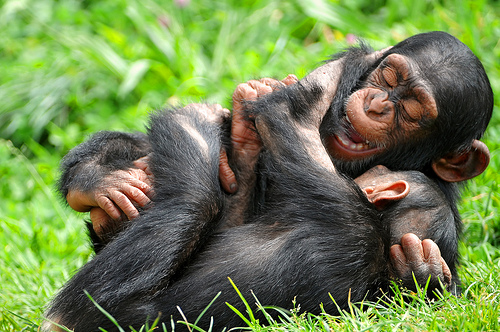Laughter in Chimpanzees and Humans - Biology 342 Fall 2012
By Yuan Xue, Soso
What Benefits Does Laughter Behavior Bring to Primates?
Laughter As a Feedback Signal In Social Environment
A study has been conducted on the circumstances of human laughter (Provine & Fischer, 1989), strikingly, laughter was 30 times more frequent in social than solitary situations. When the subjects were recorded in solitary environment, they were much more likely to talk to themselves or smile rather than making speech-laugh vocalization that resembles laughter. In a social setting between two individuals, speakers in the study laughed an average of 46% more than their audience. The study suggested that laughter is a signal that we send to others, not to ourselves. Another study conducted on gender differences in laughter patterns of humans showed that females laughed 126% more than their male counterparts in recording of conversation between two individuals. Female laughter was also found to be a predictive indicator of the female subjects' self-reported interest in the male counterpart that she was talking to; females laugh most in the presence of men whom they find attractive or interesting (Grammer and Eibl-Eibesfeldt, 1990). Taken along with the role of a feedback signal that laughter plays in social and playful activities (Provine 1993), laughter may serve as a feedback signal during intersexual selection. Whether laughter serves as a genuine feedback signal is debatable; as we previously highlighted in the ontogeny section, adult humans are often proficient at mimicry of others' emotional expression without truly feeling the emotions. Laughter may also be used in a context where one participant of the interaction does not want to make the other participant "feel bad" for failing to elicit positive emotions.The employment of laughter effectively in humans may increase proficient mate choice behavior and enhance the likelihood of social bonding and cooperation with other members, resulting in increased life-time survival fitness. Perhaps the benefit of laughter provides one effective mean for humans to communicate in their highly complex and sophisticated social structure in order to maximize individual survival fitness and replication success.

Laughter is an important communication signal in social bonding.

Just as laughter is used often as a feedback signal in human social interactions, chimpanzees employ laughter as feedback during physical interactions. A study conducted on recording of laughter-like behavior reveals that between individuals who frequently displayed laughter-like behavior, the frequency of aggressive escalation is significantly reduced (Waller et al., 2005). Additionally, the study observed that laughter behavior is mostly frequently displayed during play/wrestle between individuals, and it is most often correlated with affinitive behavior such as mutual grooming. Collectively, the evidence suggests that laughter plays a role in social bonding and lowers frequency of antagonistic actions with other members in a chimpanzee's society. As we have previously mentioned in the ontogeny section, a young chimpanzee relies on laughter to signal a positive feedback for continued physical interaction with another individual. This form of communication helps young chimpanzees to signal when physical interaction has a playful purpose, which reduces likelihood of inter-communal aggressive display that can result in maiming, or even death of a participant. Additionally, laughter may very likely be a rudimentary form of communication for young chimpanzees to align with other members for protection. Although no study has been conducted on the correlation between intersexual selection and laughter response, evidence from studies so far suggest that the role of laughter in a chimpanzee society share many common grounds with that in humans.